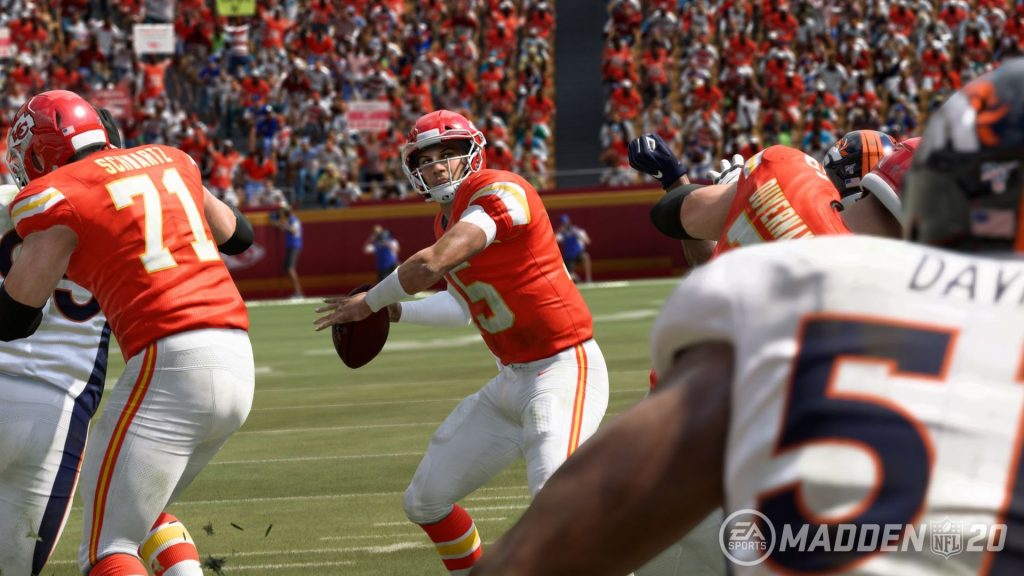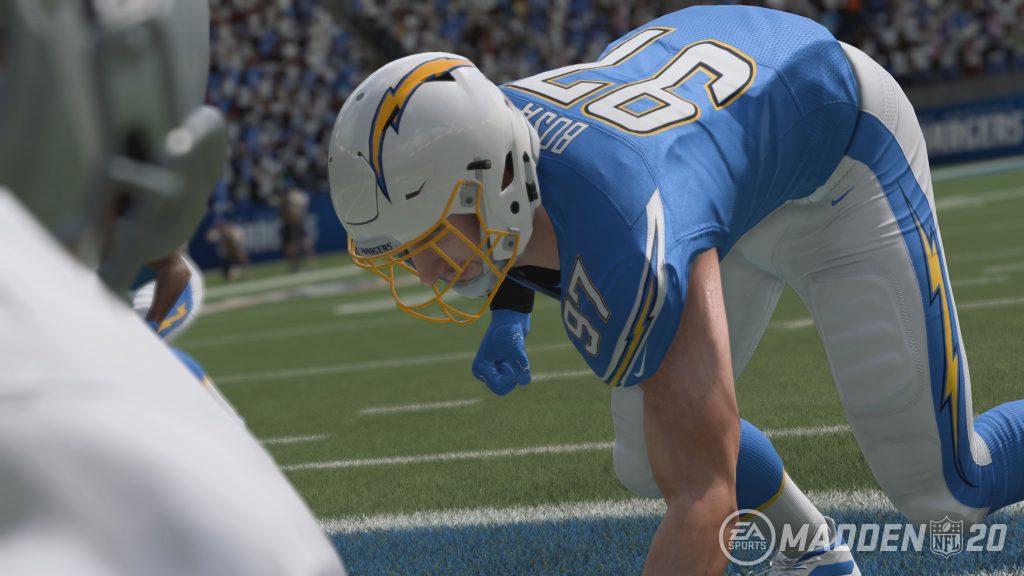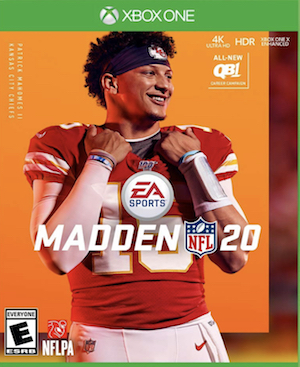
Patrick Mahomes looks so happy on the cover of Madden NFL 20. Why wouldn’t he be? He has fame, fortune, and the NFL MVP award, and it’s only his second season. It’s a shame the Madden cover curse exists, and things will be all downhill this season. The most recent stars to grace the cover bear this out. Gronk was on the cover for Madden 17, and got hurt. Tom Brady was on the cover two years ago when the Patriots lost the Super Bowl to a backup quarterback. Antonio Brown was on the cover last year, and he had one of the most contentious divorces from a team (the Steelers) in modern memory only to wind up in… Oakland? That will be…um…something. Mahomes may have made the leap to superstardom last year, but the cover curse is resolute and immortal. Somehow, some way, things will be bad next year.
The game to bear his likeness doesn’t necessarily bear that out, however. This year’s Madden, in fact, might be the best the series has played in some time. Unfortunately, it’s also a victim of the success of the last few games in the series. Yes, this is probably the best Madden in the last few years, but it’s also built on the shoulders of all the games that came before it this generation. The improvements here, while welcome, are, except for X-factor and Superstar abilities, rather slight, and the majority of the game remains largely the same as it has been for the last few years. The changes made actively make the game better, but if you’ve played the last couple of Maddens and aren’t a die hard fan, you might be wondering what the fuss is all about.
"Mahomes is the only one with Bazooka, which increases his max throwing distance by 15+ yards."
The biggest addition is Superstar and X-Factor abilities, which seem like such an obvious addition that I’m not sure why they weren’t added before. Essentially, they boil down to special abilities that elite players posses that make them play more like their real-life counterparts. There are a lot of Superstars in the game today, and they each have an ability that makes them better at what they do, whether it’s pass rushing, passing, or playing in coverage. The most elite players – the top 50 as selected by the good folks who make Madden – have what are called X-factor abilities, which can be activated if a player does well by, say, completing multiple passes in a row or catching a lot of deep balls. Once active, these abilities can quite literally change the game.
The best players, usually quarterbacks, have multiple abilities, but each only has one X-factor, and they vary between players. Tom Brady and Ben Roethlisberger, for example, share the Pro Reads X-factor, which highlights the first open receiver if they’re in the pocket. The rest of their abilities are different, however. Big Ben has Last Ditch and Sleight of Hand, among others, which gives him a higher chance to get a pass off while being sacked and a higher chance of success on pump fakes and double moves, respectively. Tom Terrific, on the other hand, has Hot Route Master, which gives him four additional hot routes, and Conductor, which makes hot routing and blocking adjustments faster. But other quarterbacks have different abilities. Drew Brees and Philip Rivers share the Fearless X-factor, which means their throw accuracy is unadjusted by defensive pressure, but the rest of their abilities are completely different. Aaron Rodgers is the only character with the Gambler ability, which makes it so that AI-controlled defenders cannot intercept his passes, while Mahomes is the only one with Bazooka, which increases his max throwing distance by 15+ yards.
Other positions have different X-factors. Pass rushers generally have Fearmonger, which gives them a chance to pressure the QB while engaged with a blocker, while receivers might have Double Me, which means they will win aggressive catches in single coverage, or RAC ‘em Up, where they win RAC catches. Corners generally have Shutdown, which gets them more INTs, while running backs might have First One Free, which increases the fakeout rate on their next evasive move. And it goes on and on, by position and player. The game even provides a handy list of who has what ability, regardless of whether they’re good enough to have an X-factor. In games, the abilities do exactly what they say they’ll do, and X-factor characters are marked with a giant X showing you who they are and if their abilities are active. Activating abilities makes a huge difference and rewards you for playing to your players’ strengths, impacting your gameplan and what the other team is capable of. Created and drafted players also have a chance to develop these abilities if they play well enough, and it’s a lot of fun to figure out who has what and see what abilities work best for your playstyle. Overall, it’s an excellent addition, and one that I hope will be brought into future games.
"There’s a bigger emphasis on relationships in Franchise Mode. If you’re a coach, a player who is unhappy with how they’re being used might contact you and ask you to be a bigger part of the next game. You can agree to get them involved, which will boost their morale, but you’ll have to follow though and complete certain goals."
Many of the core modes have also received tweaks. The biggest new addition is Pro Bowl, which allows you to play the game of the same name with the last rosters to be a part of it. It’s fun to have an All-Star game where X-factors and abilities are everywhere, and it does a good job of showing off the new system, though I wonder how much adding a single game with mixed up teams and new uniforms really matters. Franchise Mode has also seen upgrades, many of which are welcome. You can still play as a coach, player, or owner, though things have been tweaked quite a bit. Many things remain the same: you still choose from many of the same archetypes, still practice the same way, and still scout players, manage salaries, and everything else your player, coach, or owner would normally do. Now, however, there’s a bigger emphasis on relationships. If, for example, you’re a coach, a player who is unhappy with how they’re being used might contact you and ask you to be a bigger part of the next game. You can agree to get them involved, which will boost their morale, but you’ll have to follow though and complete certain goals. Failure to do so will see their morale drop.
A player might also contact you after an excellent game, saying they feel like they can contribute more. Making sure they do will allow them to level up their development trait, which will mean they’ll gain more experience and, if their level gets high enough, gain a Superstar or X-factor trait. These requirements are often tough, however, and you may not reach them, sending that player back to square one. Coaches will also have to communicate with reporters and their offensive and defensive coordinators, who will offer advice on upcoming games and how to deal with star players. You’ll ultimately choose what to do, but if you disregard them and it doesn’t work, you’ll hear from them. You can also choose whether to mentor or have other players mentor certain players, and generally manage the locker room. Players have similar options, building relationships with teammates and coaches that affect their stats and alter the course of the game.
Upgrading your players has also had a bit of an overhaul. Instead of upgrading specific stats, you’ll pick general skills you want to improve. Improving blocking for a tight end, for instance, will upgrade several skills that improve your character’s ability to block, not just one. It’s a more realistic system that emphasizes the new social stats, and makes the answer to “hey coach, what skills should I work on?” possible to answer. Scouting will also now tell you whether a player fits your scheme, and maybe even development traits, which range from normal to X-factor Superstar and determine how fast they gain experience and what skills, if any, they have. All these things make franchise mode easier to invest in, no matter what role you play, and there’s more desire to stay in for the next draft or the next season, knowing you might find a player with Superstar talents or get your custom character another shot at meaningful progression. There have also been several UI changes independent of franchise mode that tell you about things like pass and kick accuracy. These are minor changes, but they make a big difference.
"The last major mode is Face of the Franchise, which replaces the excellent Longshot that has served as Madden’s story mode for the past few years. "
Ultimate Team has seen some tweaks, too. The biggest of these are missions, which give you objectives to complete so you can get the players you want. The new setup is much clearer and more well laid out than previous games, and I rarely felt prompted to spend money, though it’s obviously what EA wants you to do. Opening packs of player is accompanied by shiny animations, and if you don’t have enough material to do something like, say, upgrade a card, the game is more than happy to redirect you to the auction house so you can buy it (though, admittedly, you can use in-game currency). Still, the addition of missions is a great one, and it makes it easier to get invested in Ultimate Team, should you choose to.
The last major mode is Face of the Franchise, which replaces the excellent Longshot that has served as Madden’s story mode for the past few years. The story is eerily like Friday Night Lights: your created character is a five-star recruit, who gets his choice of one of ten colleges. I went with Texas. You expect to start, but the top recruit in the country decommits and comes to your school. Four years later, you’re still riding the bench when he gets hurt during the college playoffs. You step in in the semi-finals having never thrown a pass. How well you play determines what happens, from whether you advance in the playoffs and win the National Championship, to how well you do in the draft.
As you play, your choices and interactions will develop not only your traits as a player, but your standing with other characters. Do you take credit for playing well, or pass it on to the team? Are you honest with the teams interviewing you, or do you try to impress? When your coach restricts the playbook, do you get angry, or take it in stride? Your decisions, as well as how you perform, matter, affecting your relationships and your draft status. I managed to win the National Championship and do well enough at the Combine that I was drafted in the first round by the Dolphins, but it all depends on how well you play. Once drafted, your performance determines whether you make the team, and how well the season goes. At this point, it largely transitions into Franchise mode, but the new additions mentioned earlier, as well as a continuing story and recurring characters, make it unique, if not as detailed as Longshot. It’s a great addition, even if I did miss Longshot’s more detailed story, and I’m curious to see how different things could be, and how my character’s story is going to turn out.
"Madden NFL 20 is proof that a lot of small improvements can make a big difference. Aside from X-factor and Superstar abilities, much of what’s here is refinement, not reinvention, but these changes go a long way."
Beyond that, much of what’s here, like the excellent Skill Trainer and overall setup of Exhibition Mode, are carryovers from previous entries, but this isn’t a bad thing. Madden NFL 20 is proof that a lot of small improvements can make a big difference. Aside from X-factor and Superstar abilities, much of what’s here is refinement, not reinvention, but these changes go a long way. Franchise Mode now feels like more than just a series of menus to navigate while you continue a season, and Face of the Franchise makes your story more personal than it has ever been. X-factor and Superstar abilities change how the game plays on a fundamental level, and give you more of an incentive to keep playing, drafting new talent, and developing existing players, no matter what mode you’re in. Add in the improvements to Ultimate Team, and the overall quality of life, and you have a game that’s easy to invest in and a lot of fun to play.
It still isn’t perfect. There are graphical glitches, the commentators often give incorrect information relating to the time left on the clock or the score, and the game sometimes tracks stats incorrectly. But these aren’t frequent issues, and they rarely detract from the overall experience. Madden NFL 20 may not rewrite the playbook, but exciting new additions like X-factor, upgrades to Franchise Mode, and new modes like Face of the Franchise prove there is life in even the oldest schemes as long as you do them right.
This game was reviewed on the PS4.
X-factor and SuperStar abilities are a fantastic addition. Lots of additions to Franchise Mode. Playing the Pro Bowl is cool. Face of the Franchise is a fun take on career mode. Missions are a great upgrade to ultimate team. It still plays really real.
Still a bunch of glitches in commentary, stats, and even finishing games properly. A lot of the upgrades are pretty minor.





















